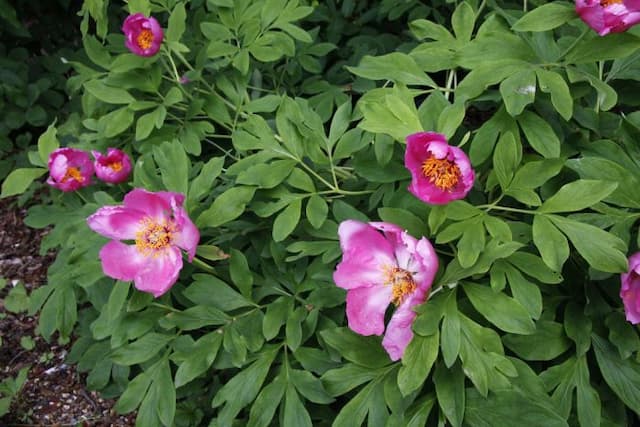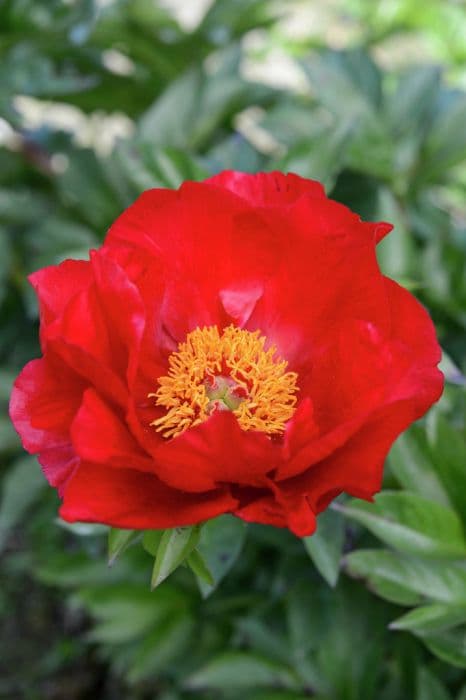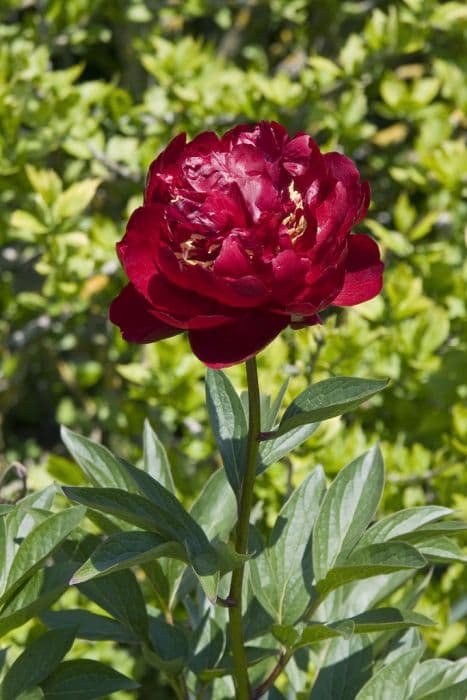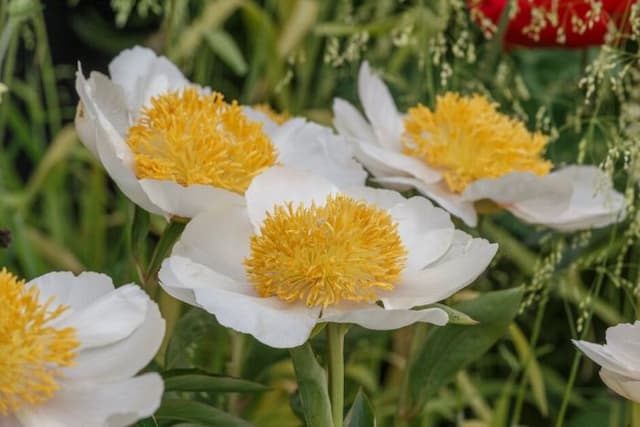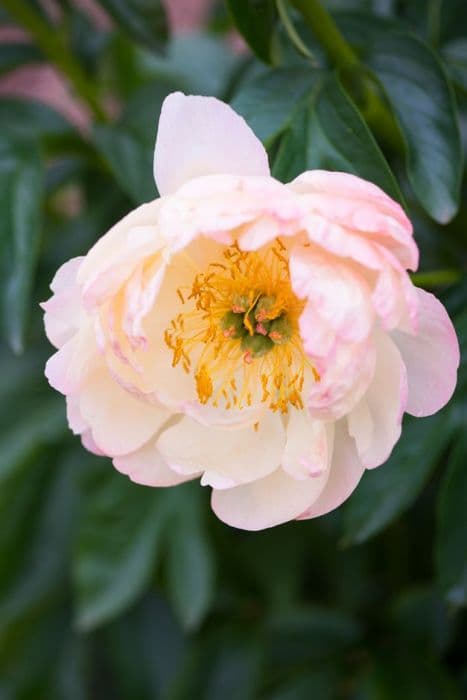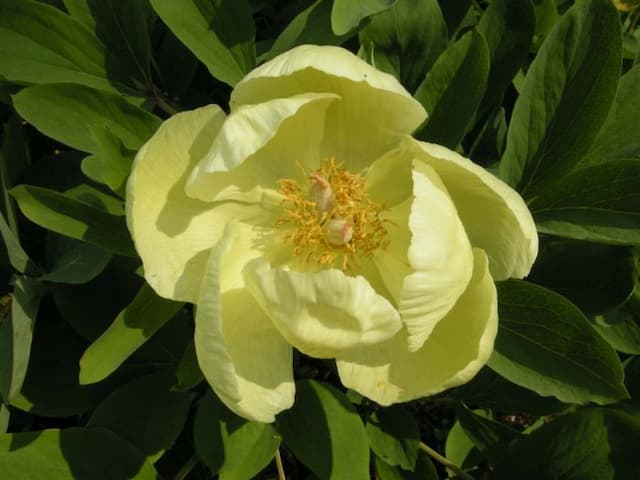Peony Paeonia lactiflora 'Dinner Plate'

ABOUT
The 'Dinner Plate' peony is known for its large, showy flowers which resemble the size of a dinner plate, hence the name. The blooms exhibit an exquisite layering of ruffled petals that can range in color from soft pinks to creamy whites, often with a subtle hint of blush or deeper pink at the petal base. As the flowers unfurl, they reveal a dense pack of ruffled petals that create a full, almost spherical shape, which exudes a lush, opulent appearance. The petals have a silky, lustrous surface, which can sometimes catch the light, giving the blossom a glow and a delicate allure. The center of each flower is typically dotted with a cluster of yellow stamens, which contrast beautifully with the predominantly pastel hues of the petals and add a touch of vibrancy to the blossom. The foliage of the 'Dinner Plate' peony is a rich green, forming a substantial backdrop for the impressive flowers. The leaves are broadly lance-shaped with a smooth margin and are arranged alternately along the sturdy stems which provide adequate support for the weighty blossoms. Throughout its blooming season, this peony variety provides an eye-catching display and is often favored in gardens for its striking ornamental value. The plant becomes a focal point when in bloom, especially because of the size and beauty of its flowers. The 'Dinner Plate' peony is also cherished for its pleasing fragrance, which can be described as a gentle, sweet aroma that lingers in the garden air.
About this plant
 Names
NamesFamily
Paeoniaceae.
Synonyms
Chinese Peony, White Peony, Common Garden Peony.
Common names
Paeonia lactiflora.
 Toxicity
ToxicityTo humans
Peonies, including the Paeonia lactiflora 'Dinner Plate', are considered to be of low toxicity to humans. Ingesting parts of the plant can cause mild stomach upset, but is generally not considered to be poisonous. Symptoms are unlikely to be severe, but could include nausea, vomiting, or diarrhea if ingested in large quantities.
To pets
Peonies are also considered to be of low toxicity to pets. If pets consume parts of the plant, they may experience gastrointestinal upset, including symptoms like vomiting or diarrhea. While the plant is not highly toxic, it can cause discomfort if ingested, and it's generally advised to prevent pets from eating ornamental plants to avoid any potential issues.
 Characteristics
CharacteristicsLife cycle
Perennials
Foliage type
Deciduous
Color of leaves
Green
Flower color
Pink
Height
2-3 feet (60-90 cm)
Spread
2-3 feet (60-90 cm)
Plant type
Herb
Hardiness zones
3-8
Native area
Asia
Benefits
 General Benefits
General Benefits- Aesthetic Appeal: With their large, bowl-shaped blossoms, peonies like 'Dinner Plate' add dramatic beauty to any garden.
- Perennial Growth: Once established, peonies come back year after year with minimal care, making them a long-term addition to the landscape.
- Spring/Early Summer Bloom: They offer vibrant blooms in the late spring to early summer, providing seasonal interest in the garden during this time.
- Attracts Pollinators: Peonies attract bees and other pollinators, which are essential for a healthy garden ecosystem.
- Drought Tolerance: Once established, peonies are relatively drought tolerant and can survive in periods of low water availability.
- Cut Flowers: The blooms of 'Dinner Plate' peonies make excellent cut flowers for arrangements, lasting well in a vase.
- Deer and Rabbit Resistance: Peonies are generally resistant to browsing by deer and rabbits, making them suitable for gardens with wildlife challenges.
- Variety of Landscapes: Peonies are versatile and can be used in borders, as specimen plants, or in mass plantings for greater impact.
- Diverse Colors and Forms: Peonies come in a variety of shades and petal arrangements, providing many options for garden design.
- Low Maintenance: They require relatively low maintenance, needing only occasional watering and fertilization, along with annual pruning.
 Medical Properties
Medical Properties- Analgesic: Peony root, from Paeonia lactiflora, is traditionally used in Chinese medicine to alleviate pain.
- Anti-inflammatory: The roots contain compounds that are believed to have anti-inflammatory effects.
- Immunomodulatory: Some studies suggest that peony extracts can modulate immune system function.
 Air-purifying Qualities
Air-purifying QualitiesThis plant is not specifically known for air purifying qualities.
 Other Uses
Other Uses- Botanical Illustration: Artists use the 'Dinner Plate' peony's large blooms as a subject for botanical illustration and watercolor painting due to its impressive and intricate structure.
- Photography Prop: The flower's size and beauty make it a favorite prop for photographers, especially in wedding and high-fashion shoots.
- Culinary Decoration: Although not for consumption, the peony can serve as an organic decoration to adorn wedding cakes and upscale pastry creations for aesthetic purposes.
- Fragrance Inspiration: The scent of the 'Dinner Plate' peony inspires perfumers to create floral fragrances that capture its subtle and delicate aroma.
- Creative Crafting: The petals can be used in papermaking or to create natural dyes for fabrics, offering a pale pink hue.
- Eco-friendly Confetti: Dried petals of the peony serve as a biodegradable confetti alternative in eco-conscious celebrations.
- Garden Design: The plant is used in garden design not only for its aesthetics but also to create a natural border or as a focal point in a perennial bed.
- Feng Shui: Some believe that peonies can bring positive energy and prosperity when planted in specific areas of a garden according to Feng Shui principles.
- Symbolic Gift: Peonies are often given as a gift representing good fortune and a happy marriage, making it a symbolic plant in ceremonial events.
- Petal Art: The large petals of 'Dinner Plate' peonies can be used for creating artistic patterns or for petal art, which includes creating designs or images from flower petals on canvas.
Interesting Facts
 Feng Shui
Feng ShuiThe Peony is not used in Feng Shui practice.
 Zodiac Sign Compitability
Zodiac Sign CompitabilityThe Peony is not used in astrology practice.
 Plant Symbolism
Plant Symbolism- Prosperity: The Paeonia lactiflora, commonly known as the Chinese peony, often symbolizes abundance and wealth due to its full, rounded blooms that resemble coins.
- Honor and Nobility: In many cultures, especially in China where it is considered the national flower, the Chinese peony is associated with honor and high social status, embodying the regal beauty of the nobility.
- Romance and Love: With its lush, soft petals, the Chinese peony is also seen as a symbol of romance, passionate love, and affection, making it a popular choice for weddings and romantic occasions.
- Beauty: Its stunning flowers are associated with physical attractiveness and feminine beauty, highlighting the natural grace and charm of the bloom.
- Good Fortune: The Chinese peony is considered a good luck charm, symbolizing a wish for good fortune and a happy life.
- Healing: Traditionally, peonies are believed to have medicinal properties, symbolizing healing and used to treat various ailments in herbal medicine.
- Compassion: Peonies can also represent compassion and empathy, embodying a sense of nurturing care and kindness.
 Water
WaterPeonies, including 'Dinner Plate', need regular watering to establish their deep root system, especially during their first few years. They should be watered deeply once a week, providing about 1 inch of water which equates to roughly 0.6 gallons per square yard of soil. It's important to avoid overhead watering to prevent fungal diseases; instead, water at the base of the plant early in the day. During the growing season, if you receive less than 1 inch of rain a week, supplement with additional water. However, once established, peonies are quite drought tolerant and will need less frequent watering. In the fall, reduce watering as the plant prepares for dormancy.
 Light
LightPeonies such as 'Dinner Plate' thrive in full sun to part shade. They need at least 6 hours of sunlight each day to bloom well. The best spot for planting 'Dinner Plate' peonies is an area where they receive morning sun and some afternoon shade, particularly in hotter climates. Avoid placing them in deep shade as this will reduce flowering and can lead to weak stems.
 Temperature
Temperature'Dinner Plate' peonies are hardy and can withstand a wide range of temperatures. They prefer a temperate climate and can tolerate winter temperatures down to about -20°F. The ideal growing temperature for peonies is between 65°F and 75°F during the day. Extreme heat over 85°F for prolonged periods may affect bloom quality and longevity.
 Pruning
Pruning'Dinner Plate' peonies should be pruned to remove spent blooms after flowering to maintain a tidy appearance and promote plant health. Pruning in the fall is also recommended; cut back the stems to about 3 inches from ground level after the first frost. This helps prevent disease and prepares the peony for winter. Remove any foliage or stems that show signs of disease or damage throughout the growing season to keep the plant healthy.
 Cleaning
CleaningAs needed
 Soil
SoilPeonies such as 'Dinner Plate' thrive in well-drained, fertile soil with a neutral to slightly alkaline pH, ideally between 6.5 and 7.5. A good mix would be equal parts garden soil, compost or well-aged manure, and sharp sand to improve drainage.
 Repotting
RepottingPeonies like 'Dinner Plate' do not need frequent repotting and can thrive for many years without being disturbed. They should be repotted if they outgrow their container or every 3-4 years to replenish the soil.
 Humidity & Misting
Humidity & MistingPeonies, including the 'Dinner Plate' variety, prefer average humidity levels and do not require special humidity considerations; they handle the ambient outdoor humidity well.
 Suitable locations
Suitable locationsIndoor
Peonies like 'Dinner Plate' struggle indoors; they need cold to flower.
Outdoor
Plant in full sun, ensure well-drained soil, mulch, and water deeply.
Hardiness zone
3-8 USDA
 Life cycle
Life cycleThe Chinese peony 'Dinner Plate' begins its life cycle as a dormant tuberous root, which, when planted in the fall, will overwinter in the soil. In early spring, red shoots emerge from the ground, developing into large, green, divided foliage. By late spring, the plant produces large, showy flowers, often resembling a "plate" in size, on sturdy stems, with blooms lasting for 7-10 days under favorable conditions. After flowering, the plant enters a period of vegetative growth throughout the summer, where it stores energy in the roots for the next season. As autumn arrives, the foliage begins to die back, and the plant returns to dormancy, preparing to withstand the winter. The cycle repeats yearly, with the plant potentially living for decades and maturing in size and bloom quantity with age.
 Propogation
PropogationPropogation time
Early Fall
Propogation: Peony 'Dinner Plate', scientifically known as Paeonia lactiflora, is commonly propagated by division, which is best done in the fall, typically after the plant has gone dormant. To propagate by division, carefully dig up the entire peony clump ensuring minimal damage to the roots. Wash or gently shake off the soil so you can see the root structure clearly. Look for divisions that have at least three to five eyes, which are the small reddish buds from which new shoots will grow. Using a sharp knife or spade, cut the tuber so that each division has a portion of the tuber and a few eyes. Replant the divisions promptly at a depth of about 1.5 to 2 inches (3.8 to 5 centimeters) below the soil surface in a well-drained, sunny location. Water the newly planted divisions thoroughly to help establish them.
